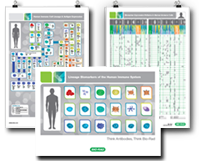CD83: A Dendritic Marker with Regulatory Function

- On This Page
- Overview
- CD83 antibodies
- Further reading
Overview
CD83, a 40-45 kDa cell surface glycoprotein, is a member of the Ig superfamily with an external IgV domain. A high degree of conservation is seen between CD83 from different organisms, with 63% amino acid identity between human and mouse forms, and homologs found in elasmobranch and teleost fish.
Dendritic cells (DCs) are the most potent antigen presenting cells (APCs) in the immune system, and are able to stimulate naïve T cells. During the immature stage before antigen uptake, DCs reside in the peripheral tissues. Once antigen has been taken up, DCs migrate to the T cell areas of the peripheral lymph nodes where they express additional cell surface molecules that result in binding and stimulation of T cells, leading to an immune response.
CD83 is a well-recognized marker for mature dendritic cells. It is expressed as a cell surface molecule on thymic, circulating, and monocyte derived DCs, as well as Langerhans cells in the skin, interdigitating reticulum cells in the T cell zones of lymphoid organs, and microglia. Low level expression has also been reported on activated T and B cells. In addition, CD83 can be expressed in a soluble form, and is able to down-regulate DC maturation and stimulation of T cells. When CD83 expression was disrupted in mice, CD4+ T cell generation was impaired.
Bio-Rad manufactures the following antibodies specific for human and mouse CD83:
Anti-human CD83 (MCA1582, clone HB15e) is available in a wide range of sizes and formats, including smaller size vials for testing and proof of concept. It has been conjugated to Alexa Fluor® 488, Alexa Fluor® 647, Biotin, FITC, RPE, and RPE-Cy5 for flow cytometry, and is also performance-guaranteed in the purified format for immunoprecipitation, and histology staining on paraffin and frozen sections.
Anti-mouse CD83 (MCA2747, clone 3D11) is available as purified or conjugated to Alexa Fluor® 488, Alexa Fluor® 647, and FITC for flow cytometry.
CD83 Antibodies
| Description | Target | Format | Clone | Applications | Citations | Code |
|---|
Further reading:
-
Zhou, L-J. et al. (1992) A novel cell-surface molecule expressed by human interdigitating reticulum cells, Langerhans cells, and activated lymphocytes is a new member of the Ig superfamily.
J. Immunol. 149 (2): 735-742 -
Zhou, L-J. and Tedder, T.F. (1995) Human blood dendritic cells selectively express CD83, a member of the immunoglobulin superfamily.
J. Immunol. 154 (88): 3821-3835 -
Zhou, L-J. and Tedder, T. F. (1995) ‘A distinct pattern of cytokine gene expression by human CD83+ blood dendritic cells.
Blood 86: 3295-3301 -
Lechmann, M et al. (2001) The extracellular domain of CD83 inhibits dendritic cell–mediated T cell stimulation and binds to a ligand on dendritic cells.
J Exp Med. 194(12):1813-21 -
Fujimoto, Y. and Tedder, T.F. (2006) CD83: A regulatory molecule of the immune system with great potential for therapeutic application.
J. Med. Dent. Sci. 53:85 – 91



